Spatiotemporal Pattern of Fine Particulate Matter and Impact of Urban Socioeconomic Factors in China
Abstract
1. Introduction
2. Materials and Methods
2.1. Data Sources and Pre-Processing
2.1.1. PM2.5 Data
2.1.2. Land Use Data
2.1.3. Administrative Boundary, Social and Economic Data
2.2. Methodology
2.2.1. Trend Analysis of the PM2.5 Concentration
2.2.2. Model Building
3. Results
3.1. Spatial Pattern and Grade Variation in PM2.5 Concentration for 2000–2015
3.2. Trends of the PM2.5 Concentration for 2000–2015
3.3. Impact of Urban Socioeconomic Factors on the PM2.5 Concentration
4. Discussion
4.1. Change of PM2.5 Concentration in the Past 15 Years
4.2. Land Use and PM2.5 Pollution
4.3. Urban Factors and PM2.5 Pollution
4.4. Limitations
4.5. Action and Policy Recommendations to Control PM2.5 pollution
5. Conclusions
Author Contributions
Funding
Acknowledgments
Conflicts of Interest
References
- Liu, M.; Liu, X.; Huang, Y.; Ma, Z.; Bi, J. Epidemic transition of environmental health risk during China’s urbanization. Sci. Bull. 2017, 62, 92–98. [Google Scholar] [CrossRef]
- Han, L.J.; Zhou, W.Q.; Li, W.F. Fine particulate (PM2.5) dynamics during rapid urbanization in Beijing, 1973–2013. Sci. Rep. 2016, 6, 23604. [Google Scholar] [CrossRef] [PubMed]
- Han, L.J.; Zhou, W.Q.; Li, W.F.; Meshesha, D.T.; Li, L.; Zheng, M.Q. Meteorological and urban landscape factors on severe air pollution in Beijing. J. Air Waste Manag. Assoc. 2015, 65, 782–787. [Google Scholar] [CrossRef]
- Pope, C.A., 3rd; Dockery, D.W. Health effects of fine particulate air pollution: Lines that connect. J. Air Waste Manag. Assoc. 2006, 56, 709–742. [Google Scholar] [CrossRef]
- Ma, Y.-R.; Ji, Q.; Fan, Y. Spatial linkage analysis of the impact of regional economic activities on PM2.5 pollution in China. J. Clean. Prod. 2016, 139, 1157–1167. [Google Scholar] [CrossRef]
- Han, L.J.; Zhou, W.Q.; Li, W.F.; Li, L. Impact of urbanization level on urban air quality: A case of fine particles (PM2.5) in Chinese cities. Environ. Pollut. 2014, 194, 163–170. [Google Scholar] [CrossRef]
- Fang, C.L.; Liu, H.M.; Li, G.D.; Sun, D.Q.; Miao, Z. Estimating the Impact of Urbanization on Air Quality in China Using Spatial Regression Models. Sustainability 2015, 7, 15570–15592. [Google Scholar] [CrossRef]
- Beaumelle, L.; Vile, D.; Lamy, I.; Vandenbulcke, F.; Gimbert, F.; Hedde, M. A structural equation model of soil metal bioavailability to earthworms: Confronting causal theory and observations using a laboratory exposure to field-contaminated soils. Sci. Total Environ. 2016, 569–570, 961–972. [Google Scholar] [CrossRef]
- Fu, W.C.; Liu, Q.Y.; van den Bosch, C.K.; Chen, Z.R.; Zhu, Z.P.; Qi, J.D.; Wang, M.; Dang, E.; Dong, J.W. Long-Term Atmospheric Visibility Trends and Their Relations to Socioeconomic Factors in Xiamen City, China. Int. J. Environ. Res. Public Health 2018, 15, 2239. [Google Scholar] [CrossRef]
- Zhao, S.; Liu, S.L.; Hou, X.Y.; Cheng, F.Y.; Wu, X.; Dong, S.K.; Beazley, R. Temporal dynamics of SO2 and NOX pollution and contributions of driving forces in urban areas in China. Environ. Pollut. 2018, 242, 239–248. [Google Scholar] [CrossRef] [PubMed]
- Van Donkelaar, A.; Martin, R.V.; Spurr, R.J.; Drury, E.; Remer, L.A.; Levy, R.C.; Wang, J. Optimal estimation for global ground-level fine particulate matter concentrations. J. Geophys. Res. Atmos. 2013, 118, 5621–5636. [Google Scholar] [CrossRef]
- Van Donkelaar, A.; Martin, R.V.; Brauer, M.; Hsu, N.C.; Kahn, R.A.; Levy, R.C.; Lyapustin, A.; Sayer, A.M.; Winker, D.M. Global Estimates of Fine Particulate Matter using a Combined Geophysical-Statistical Method with Information from Satellites, Models, and Monitors. Environ. Sci. Technol. 2016, 50, 3762–3772. [Google Scholar] [CrossRef]
- Van Donkelaar, A.; Martin, R.V.; Park, R.J. Estimating ground-level PM2.5 using aerosol optical depth determined from satellite remote sensing. J. Geophys. Res. 2006, 111. [Google Scholar] [CrossRef]
- Boys, B.; Martin, R.; Van Donkelaar, A.; MacDonell, R.; Hsu, N.; Cooper, M.; Yantosca, R.; Lu, Z.; Streets, D.; Zhang, Q. Fifteen-year global time series of satellite-derived fine particulate matter. Environ. Sci. Technol. 2014, 48, 11109–11118. [Google Scholar] [CrossRef]
- Van Donkelaar, A.; Martin, R.V.; Brauer, M.; Boys, B.L. Use of satellite observations for long-term exposure assessment of global concentrations of fine particulate matter. Environ. Health Perspect. 2015, 123, 135–143. [Google Scholar] [CrossRef]
- Atmospheric Composition Analysis Group Home Page. Available online: http://fizz.phys.dal.ca/~atmos/martin/?page_id=140 (accessed on 18 March 2019).
- Data Center for Resources and Environmental Sciences, Chinese Academy of Sciences Home Page. Available online: http://www.resdc.cn (accessed on 18 March 2019).
- Zhang, L.; LeGates, R.; Zhao, M. Understanding China’s Urbanization: The Great Demographic, Spatial, Economic, and Social Transformation; Edward Elgar Publishing: Northampton, MA, USA, 2016. [Google Scholar]
- Fang, C.L.; Wang, D.L. Comprehensive measures and improvement of Chinese urbanization development quality. Geogr. Res. 2011, 30, 1931–1946. [Google Scholar]
- Dadao, L. Urbanization Process and Spatial Sprawl in China. Urban Plan. Forum 2007, 170, 47–52. [Google Scholar]
- Sato, Y.; Yamamoto, K. Population concentration, urbanization, and demographic transition. J. Urban Econ. 2005, 58, 45–61. [Google Scholar] [CrossRef]
- Bai, X.; Chen, J.; Shi, P. Landscape Urbanization and Economic Growth in China: Positive Feedbacks and Sustainability Dilemmas. Environ. Sci. Technol. 2012, 46, 132–139. [Google Scholar] [CrossRef] [PubMed]
- Yu-min, Y. Approach on China’s Urbanization Quality. China Soft Sci. 2001, 7, 27–31. [Google Scholar]
- Jiang, P.; Yang, J.; Huang, C.H.; Liu, H.K. The contribution of socioeconomic factors to PM2.5 pollution in urban China. Environ. Pollut. 2018, 233, 977–985. [Google Scholar] [CrossRef] [PubMed]
- Han, L.J.; Zhou, W.Q.; Pickett, S.T.A.; Li, W.F.; Li, L. An optimum city size? The scaling relationship for urban population and fine particulate (PM2.5) concentration. Environ. Pollut. 2016, 208, 96–101. [Google Scholar] [CrossRef]
- Shukla, V.; Parikh, K. The environmental consequences of urban growth: Cross-national perspectives on economic development, air pollution, and city size. Urban Geogr. 1992, 13, 422–449. [Google Scholar] [CrossRef]
- Zhang, H.; Wang, Z.; Zhang, W. Exploring spatiotemporal patterns of PM2.5 in China based on ground-level observations for 190 cities. Environ. Pollut. 2016, 216, 559–567. [Google Scholar] [CrossRef]
- Wang, S.; Zhou, C.; Wang, Z.; Feng, K.; Hubacek, K. The characteristics and drivers of fine particulate matter (PM2.5) distribution in China. J. Clean. Prod. 2017, 142, 1800–1809. [Google Scholar] [CrossRef]
- Zhou, C.; Chen, J.; Wang, S. Examining the effects of socioeconomic development on fine particulate matter (PM2.5) in China’s cities using spatial regression and the geographical detector technique. Sci. Total Environ. 2018, 619–620, 436–445. [Google Scholar] [CrossRef] [PubMed]
- You, S.; Neoh, K.G.; Tong, Y.W.; Dai, Y.; Wang, C.-H. Variation of household electricity consumption and potential impact of outdoor PM2.5 concentration: A comparison between Singapore and Shanghai. Appl. Energy 2017, 188, 475–484. [Google Scholar] [CrossRef]
- Xiao, Q.; Ma, Z.; Li, S.; Liu, Y. The Impact of Winter Heating on Air Pollution in China. PLoS ONE 2015, 10, 0117311. [Google Scholar] [CrossRef]
- Wang, Z.-B.; Fang, C.-L. Spatial-temporal characteristics and determinants of PM2.5 in the Bohai Rim Urban Agglomeration. Chemosphere 2016, 148, 148–162. [Google Scholar] [CrossRef]
- Mo, L.; Yu, X.; Zhao, Y.; Sun, F.; Mo, N.; Xia, H. Correlation analysis between urbanization and particle pollution in Beijing. Ecol. Environ. Sci. 2014, 23, 806–811. [Google Scholar]
- Lin, G.; Fu, J.; Jiang, D.; Hu, W.; Dong, D.; Huang, Y.; Zhao, M. Spatio-Temporal Variation of PM2.5 Concentrations and Their Relationship with Geographic and Socioeconomic Factors in China. Int. J. Environ. Res. Public Health 2014, 11, 173–186. [Google Scholar] [CrossRef]
- Chen, N.; Xu, L. Relationship between air quality and economic development in the provincial capital cities of China. Environ. Sci. Pollut. Res. 2017, 24, 2928–2935. [Google Scholar] [CrossRef] [PubMed]
- Wang, J.N.; Lei, Y.; Ning, M. Implementation of Air Pollution Prevention and Control Action Plan: A Declaration of War on PM2.5. Environ. Prot. 2014, 42, 28–31. [Google Scholar]
- Pui, D.Y.H.; Chen, S.-C.; Zuo, Z. PM2.5 in China: Measurements, sources, visibility and health effects, and mitigation. Particuology 2014, 13, 1–26. [Google Scholar] [CrossRef]
- Yang, L.; Cheng, S.; Wang, X.; Nie, W.; Xu, P.; Gao, X.; Yuan, C.; Wang, W. Source identification and health impact of PM2.5 in a heavily polluted urban atmosphere in China. Atmos. Environ. 2013, 75, 265–269. [Google Scholar] [CrossRef]
- Li, G. Will tertiary industry become the driving force of China’s Economic Growth. China Ind. Econ. 2013, 301, 43–55. [Google Scholar]
- Li, X.; Lin, C.; Wang, Y.; Zhao, L.; Duan, N.; Wu, X. Analysis of rural household energy consumption and renewable energy systems in Zhangziying town of Beijing. Ecol. Model. 2015, 318, 184–193. [Google Scholar] [CrossRef]
- Mo, H.; Zhu, F.H.; Wang, S. Contribution to PM2.5 of atmospheric pollutant emission from thermal power sector and emission reduction countermeasures. Electr. Power 2013, 46, 1–6. [Google Scholar]
- Lelieveld, J.; Evans, J.S.; Fnais, M.; Giannadaki, D.; Pozzer, A. The contribution of outdoor air pollution sources to premature mortality on a global scale. Nature 2015, 525, 367–376. [Google Scholar] [CrossRef]
- Mayer, H. Air pollution in cities. Atmos. Environ. 1999, 33, 4029–4037. [Google Scholar] [CrossRef]
- Li, Y.F.; Yang, Y.X.; Gao, H.; Zhu, B.; Zou, G.W. Comparison and economic and technical analysis of some heating schemes in China. Build. Energy Environ. 2004, 4, 84–89. [Google Scholar]
- Liang, X.; Li, S.; Zhang, S.; Huang, H.; Chen, S.X. PM2.5 data reliability, consistency, and air quality assessment in five Chinese cities. J. Geophys. Res. Atmos. 2016, 121, 10220–10236. [Google Scholar] [CrossRef]
- Xu, B.; Lin, B. Regional differences of pollution emissions in China: Contributing factors and mitigation strategies. J. Clean. Prod. 2016, 112, 1454–1463. [Google Scholar] [CrossRef]
- Chen, Y.; Schleicher, N.; Fricker, M.; Cen, K.; Liu, X.-L.; Kaminski, U.; Yu, Y.; Wu, X.-F.; Norra, S. Long-term variation of black carbon and PM2.5 in Beijing, China with respect to meteorological conditions and governmental measures. Environ. Pollut. 2016, 212, 269–278. [Google Scholar] [CrossRef] [PubMed]
- Wang, L.; Zhang, N.; Liu, Z.; Sun, Y.; Ji, D.; Wang, Y. The Influence of Climate Factors, Meteorological Conditions, and Boundary-Layer Structure on Severe Haze Pollution in the Beijing-Tianjin-Hebei Region during January 2013. Adv. Meteorol. 2014, 2014, 685971. [Google Scholar] [CrossRef]
- Nguyen, T.; Yu, X.; Zhang, Z.; Liu, M.; Liu, X. Relationship between types of urban forest and PM2.5 capture at three growth stages of leaves. J. Environ. Sci. 2015, 27, 33–41. [Google Scholar] [CrossRef]
- Feng, L.; Liao, W. Legislation, plans, and policies for prevention and control of air pollution in China: Achievements, challenges, and improvements. J. Clean. Prod. 2016, 112, 1549–1558. [Google Scholar] [CrossRef]
- Hu, D.; Jiang, J. A study of smog issues and PM2.5 pollutant control strategies in China. J. Environ. Prot. 2013, 4, 746. [Google Scholar] [CrossRef][Green Version]
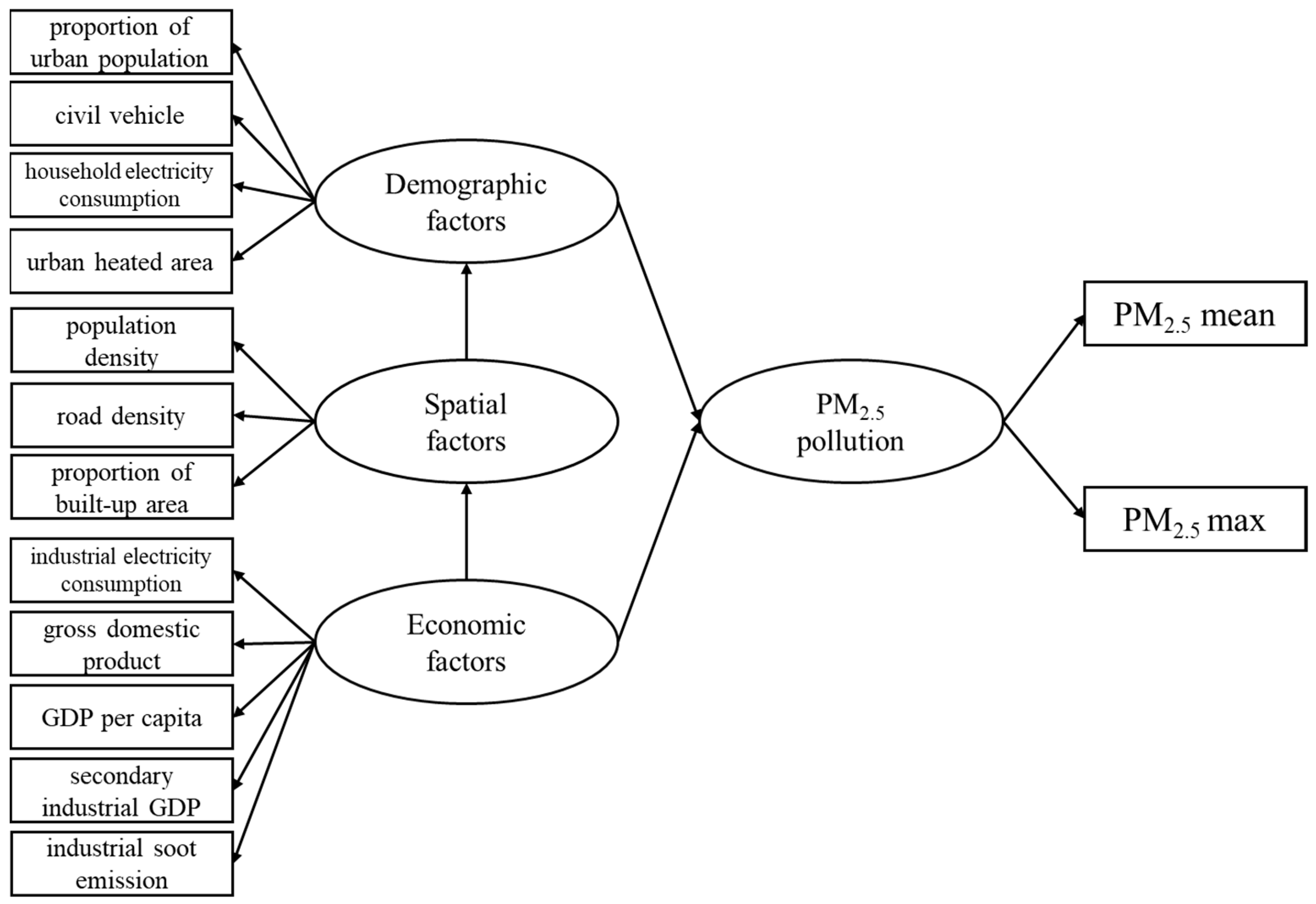

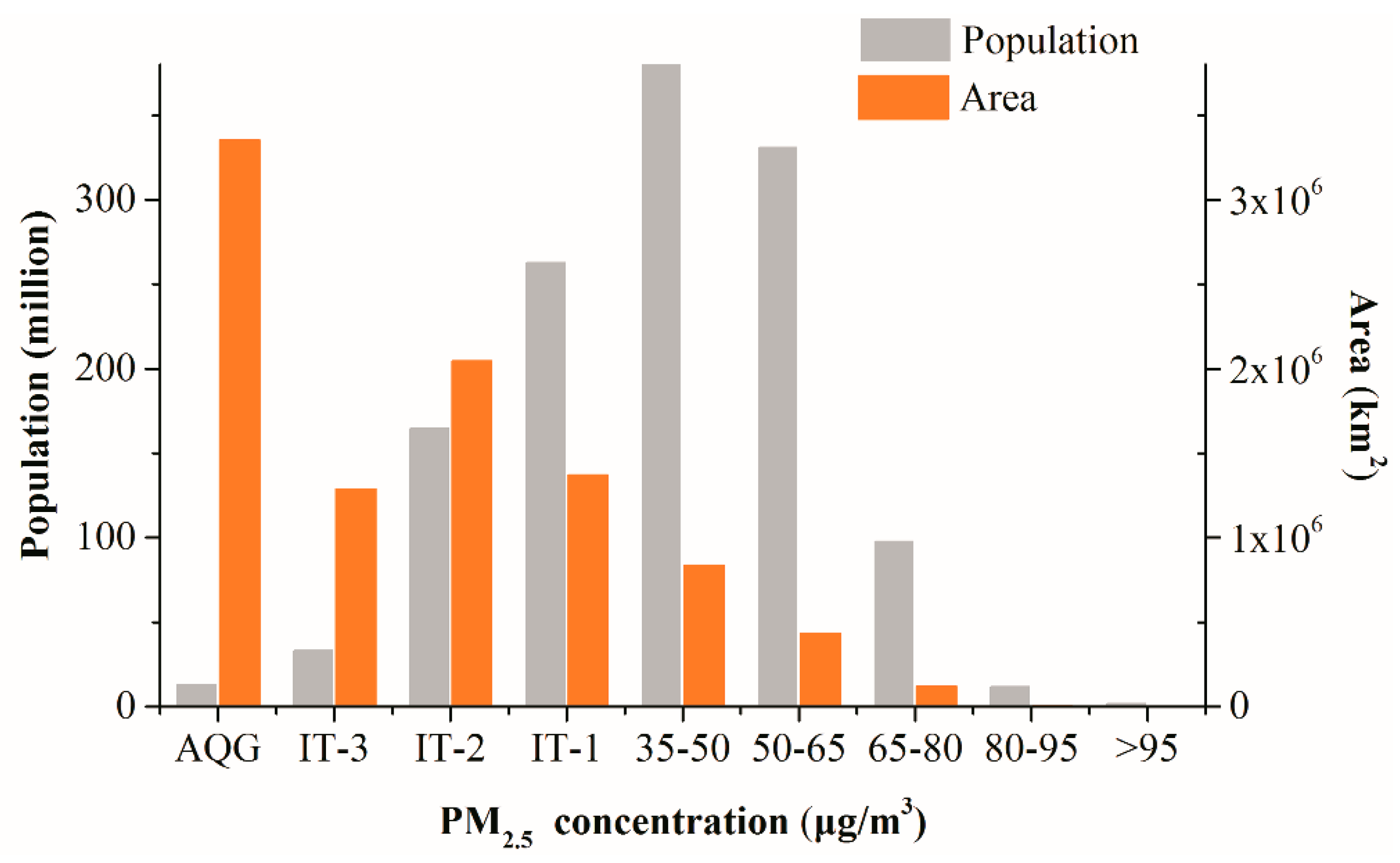

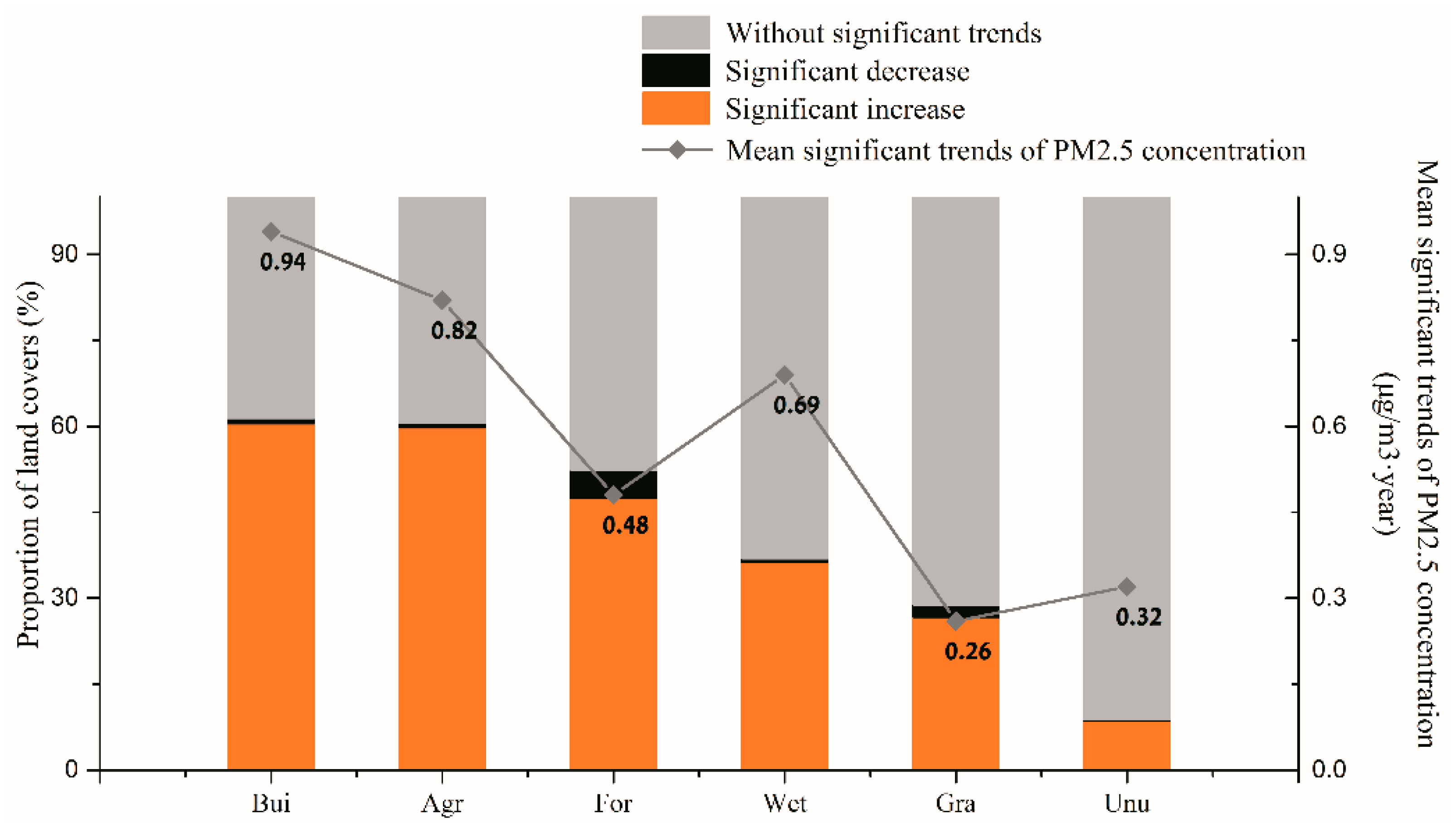
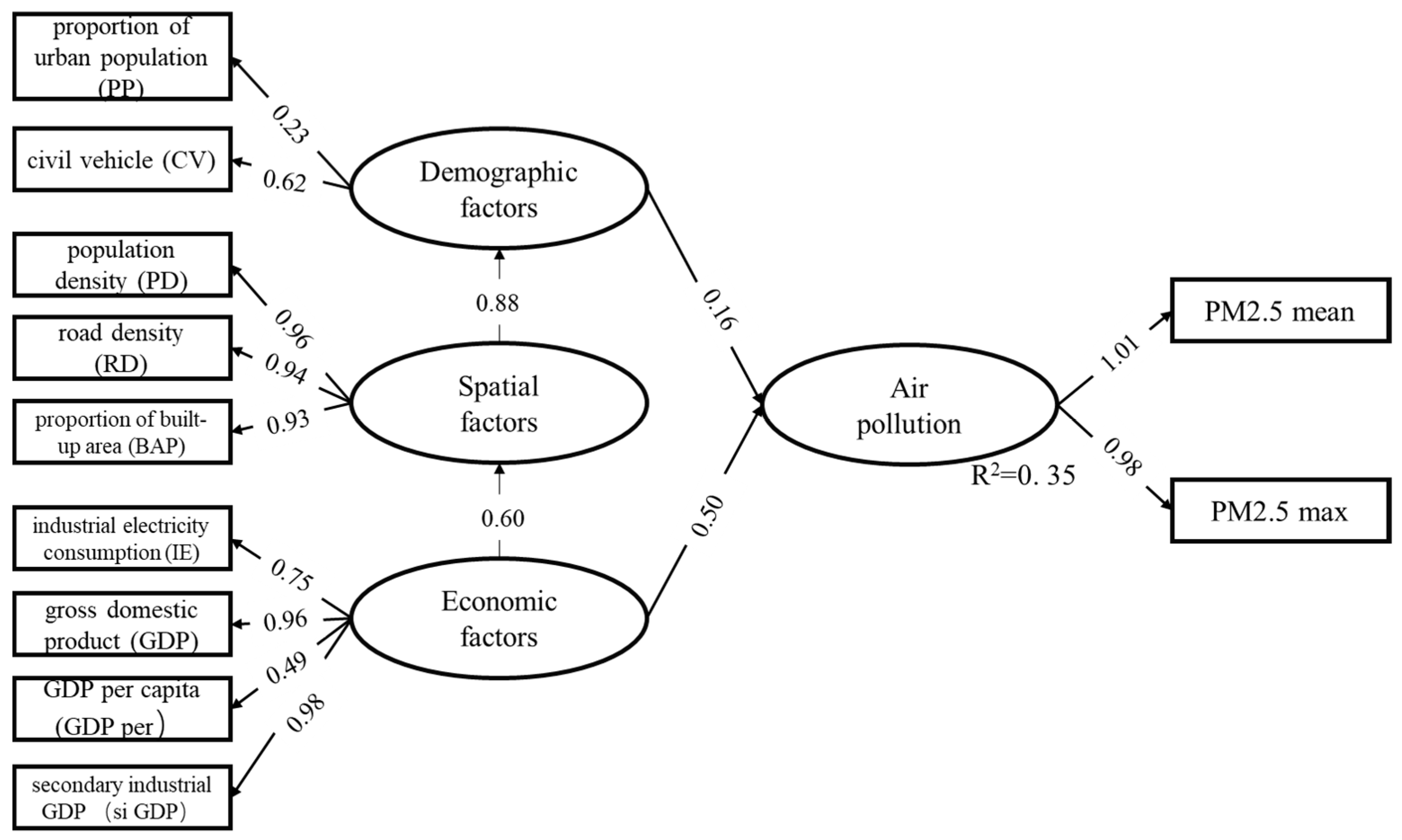
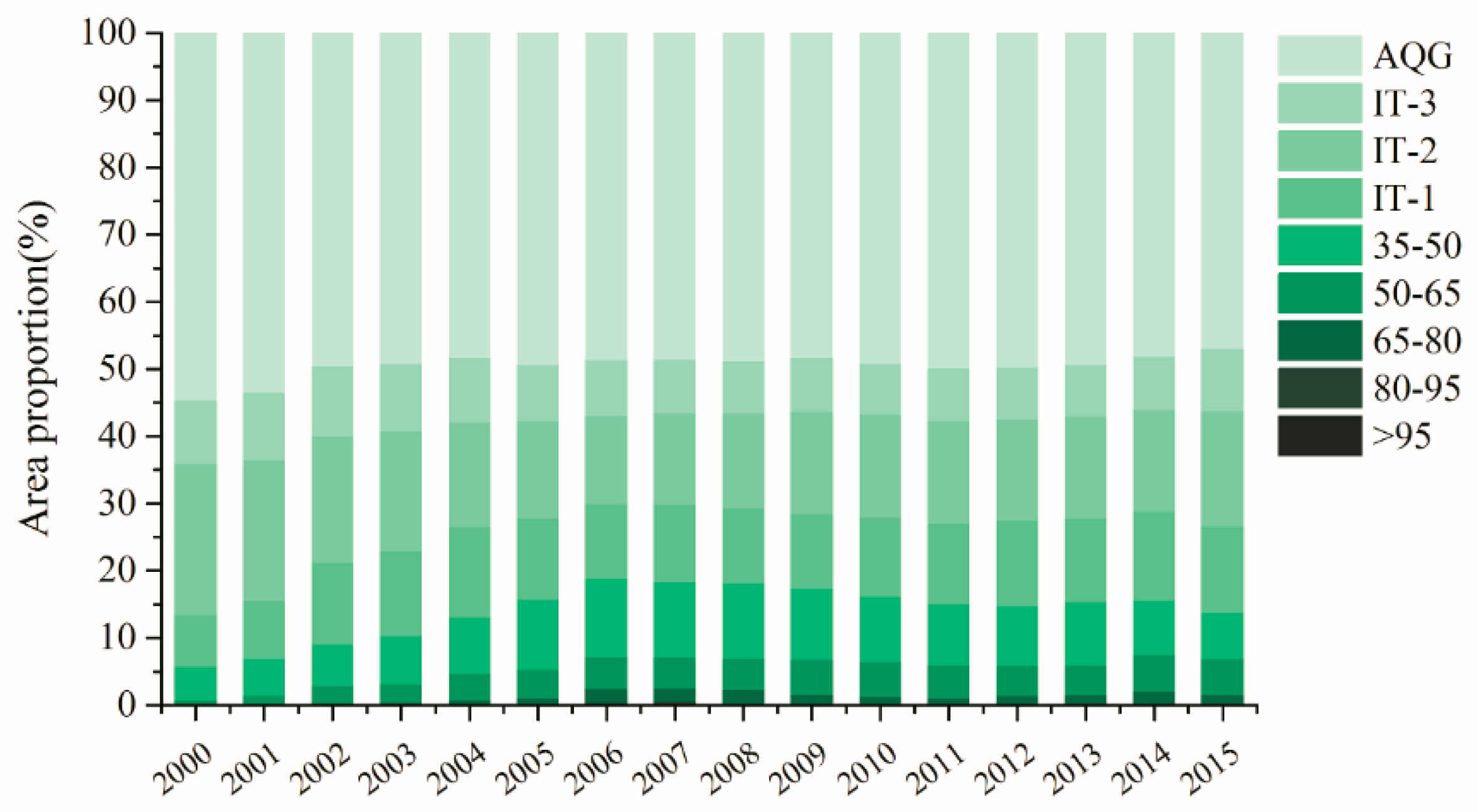
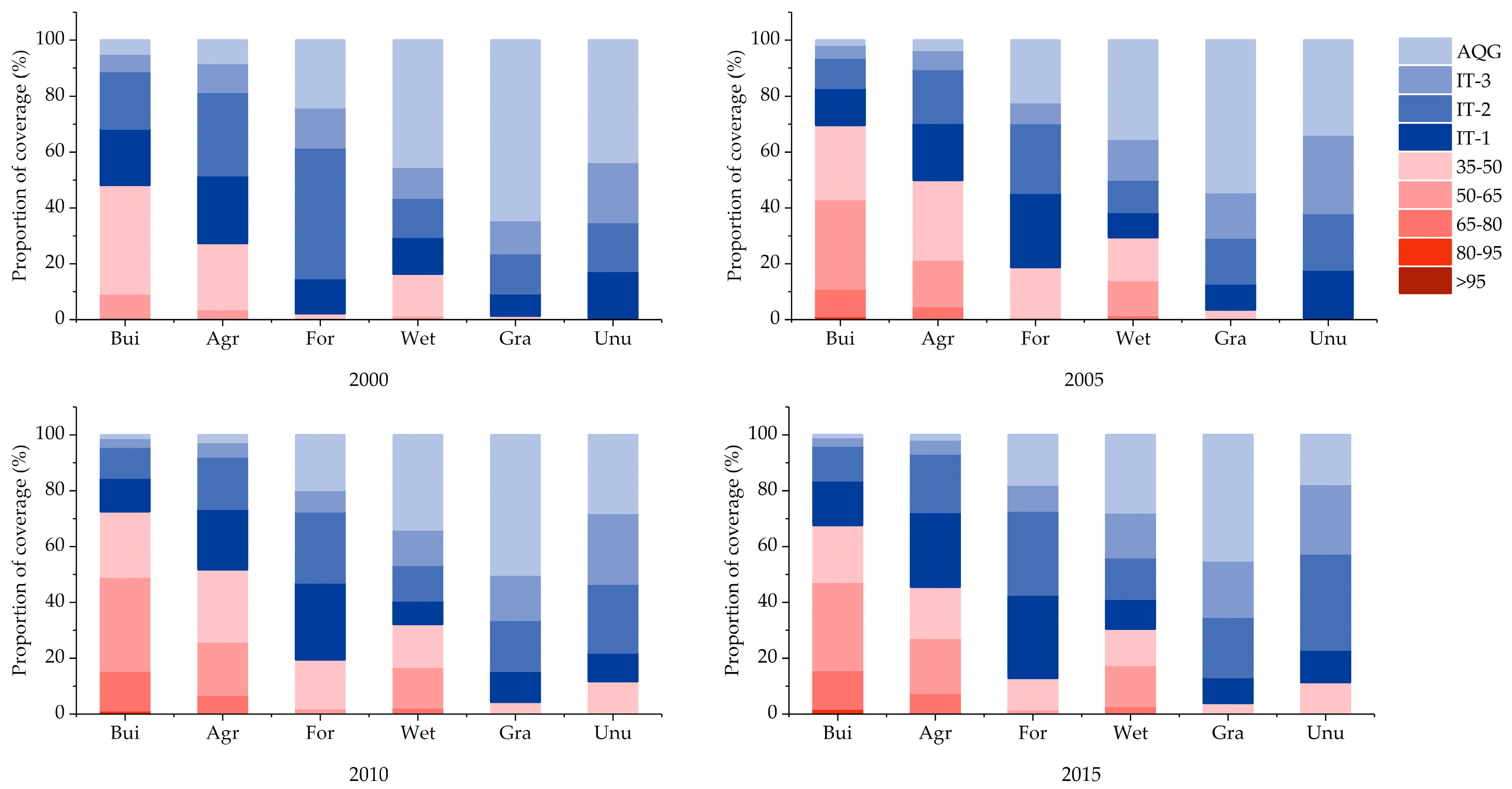
| Latent Variables | Observed Variables | Results of Previous Studies |
|---|---|---|
| Spatial factors | proportion of built-up area (BAP) | Positive, R2 = 0.36, p < 0.05, Pearson correlation analysis [6] Positive, coefficient: 0.116, regression model [27] |
| population density (PD) | Positive, coefficient: 0.14, R2 = 0.82, p < 0.05, regression model [28] | |
| road density (RD) | Positive, coefficient: 0.48, p < 0.05, regression model [29] | |
| Demographic factors | household electricity consumption (HE) | Positive, 20% decrease in the PM2.5 with 2.2% decrease of electricity consumption, generalized linear model [30] |
| urban heated area (HA) | Positive, R2: 0.51, p < 0.05, regression model [31] | |
| proportion of urban population (PP) | Positive, R2 = 0.99, p < 0.05, Pearson correlation analysis [6] | |
| number of civil vehicles (CV) | Positive, R2: 0.65, p < 0.05, regression model [2] Positive, coefficient: 0.10, Geographically weighted regression (GWR) model [32] | |
| Economic factors | industrial electricity consumption (IE) | Positive, 379Mt PM2.5 emission, statistical description [33] |
| industrial soot emission (ISE) | Positive, coefficient: 7.05664 × 10−5, p < 0.01, regression model [29] | |
| Gross Domestic Product (GDP) | Positive, R = 0.58, Geographically Weighted Regression [34] | |
| GDP per capita (GDP per) | Negative, coefficient: 0.39, R2 = 0.80, p < 0.05, regression model [28] Positive, coefficient: 0.32, p < 0.1, regression model [5] | |
| secondary industrial GDP fraction (si GDP) | Positive, coefficient: 0.34, R2 = 0.68, p < 0.05, regression model [28] Positive, coefficient: 0.36, Geographically weighted regression (GWR) model [32] Positive, coefficient: 0.52, regression model (R2 = 0.47) [35] |
| Models | Remove | χ2 | GFI | A-GFI | AIC | BIC | CFI |
|---|---|---|---|---|---|---|---|
| Original | 346.80 | 0.76 | 0.57 | 416.80 | 527.76 | 0.89 | |
| Demographic A | HE | 237.67 | 0.81 | 0.62 | 301.67 | 403.12 | 0.91 |
| Demographic B | PP | 321.35 | 0.78 | 0.56 | 385.35 | 486.80 | 0.89 |
| Demographic C | CV | 315.03 | 0.75 | 0.55 | 375.03 | 470.14 | 0.89 |
| Spatial A | PD | 319.70 | 0.76 | 0.54 | 381.70 | 479.98 | 0.88 |
| Spatial B | RD | 320.17 | 0.75 | 0.51 | 384.17 | 485.62 | 0.88 |
| Spatial C | BAP | 287.85 | 0.78 | 0.56 | 353.85 | 458.47 | 0.89 |
| Economic A | IE | 293.04 | 0.80 | 0.61 | 357.04 | 458.49 | 0.90 |
| Economic B | GDP_per | 294.87 | 0.80 | 0.62 | 356.87 | 455.16 | 0.90 |
| Economic C | GDP | 257.74 | 0.82 | 0.61 | 327.74 | 438.70 | 0.90 |
| Economic D | si GDP | 261.77 | 0.81 | 0.64 | 325.77 | 427.22 | 0.90 |
| Latent Variables | Observed Variables | Normalized Coefficient | ||
|---|---|---|---|---|
| Direct | Indirect | Total | ||
| Demographic | 0.179 | 0.000 | 0.179 | |
| PP | 0.048 | 0.000 | 0.048 w | |
| CV | 0.131 | 0.000 | 0.131 m | |
| Spatial | 0.000 | 0.158 | 0.158 | |
| PD | 0.000 | 0.053 | 0.053 w | |
| RD | 0.000 | 0.053 | 0.053 w | |
| BAP | 0.000 | 0.052 | 0.052 w | |
| Economic | 0.568 | 0.095 | 0.663 | |
| IE | 0.134 | 0.022 | 0.156 m | |
| GDP per | 0.087 | 0.015 | 0.102 m | |
| GDP | 0.172 | 0.029 | 0.201 s | |
| si GDP | 0.175 | 0.029 | 0.204 s | |
© 2019 by the authors. Licensee MDPI, Basel, Switzerland. This article is an open access article distributed under the terms and conditions of the Creative Commons Attribution (CC BY) license (http://creativecommons.org/licenses/by/4.0/).
Share and Cite
Shi, T.; Liu, M.; Hu, Y.; Li, C.; Zhang, C.; Ren, B. Spatiotemporal Pattern of Fine Particulate Matter and Impact of Urban Socioeconomic Factors in China. Int. J. Environ. Res. Public Health 2019, 16, 1099. https://doi.org/10.3390/ijerph16071099
Shi T, Liu M, Hu Y, Li C, Zhang C, Ren B. Spatiotemporal Pattern of Fine Particulate Matter and Impact of Urban Socioeconomic Factors in China. International Journal of Environmental Research and Public Health. 2019; 16(7):1099. https://doi.org/10.3390/ijerph16071099
Chicago/Turabian StyleShi, Tuo, Miao Liu, Yuanman Hu, Chunlin Li, Chuyi Zhang, and Baihui Ren. 2019. "Spatiotemporal Pattern of Fine Particulate Matter and Impact of Urban Socioeconomic Factors in China" International Journal of Environmental Research and Public Health 16, no. 7: 1099. https://doi.org/10.3390/ijerph16071099
APA StyleShi, T., Liu, M., Hu, Y., Li, C., Zhang, C., & Ren, B. (2019). Spatiotemporal Pattern of Fine Particulate Matter and Impact of Urban Socioeconomic Factors in China. International Journal of Environmental Research and Public Health, 16(7), 1099. https://doi.org/10.3390/ijerph16071099







